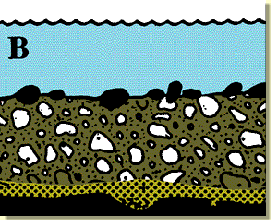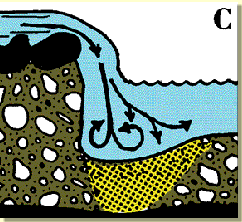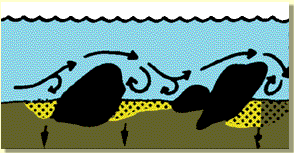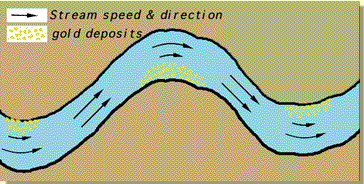![]()
![]()
![]()
![]()
Six Habits of Gold

Familiarizing yourself with these six fundamental rules, should give you a fairly good working knowledge of what happens to gold once it reaches the stream, giving you a distinct advantage over people who haven't the foggiest notion as to where to start looking.
(1) GOLD IS HEAVY
Gold is extremely heavy, six or seven times heavier than rock, and, therefore, it settles on the bottom. The key word here is down. Gold's excessive weight forces it down-downhill, downstream, down into the sands and gravel, down into bedrock cracks and crevices, and down in your sluice box or gold pan. Gold is assisted in its downward movement by wind, rain, earth tremor, rockslide and agitation. Once gold settles on the creek bed, it will sift downward through the lighter sand and gravel. Because of its weight, it will continue to sink until it reaches bedrock, where it will become trapped in crevices and such.
(2) WATER VELOCITY
 Because gold has a tendency to sink, it will
concentrate wherever the creek slows down or loses
sufficient velocity to drag it further. In other words, if
gold is dragged down a mountainside to a deep, motionless
pool, it will immediately sink to the bottom. The first
principle of prospecting, then, is to search where the flow
of water decreases. Therefore, pay special attention to the
edges of whirlpools, at the tail of eddies, beneath
waterfalls and in deeper pools. Fine gold is usually found
in the shallow areas, and coarse gold in the deeper areas. A
popular misconception is that all nuggets sink immediately
to the bottom at, or near, its source. This is generally
true, but depends a great deal upon the size of the nugget
and the flow of the water. For example, a stream flowing at
only one-half mile per hour can lift and carry gravel about
the size of a pea. At five miles per hour, stones the size
of cannon balls will tumble freely. When the velocity is
slightly greater than 20 miles per hour, boulders that weigh
nearly a ton can be moved gradually. And, during spring
run-off, the velocity is often much greater than this.
Because gold has a tendency to sink, it will
concentrate wherever the creek slows down or loses
sufficient velocity to drag it further. In other words, if
gold is dragged down a mountainside to a deep, motionless
pool, it will immediately sink to the bottom. The first
principle of prospecting, then, is to search where the flow
of water decreases. Therefore, pay special attention to the
edges of whirlpools, at the tail of eddies, beneath
waterfalls and in deeper pools. Fine gold is usually found
in the shallow areas, and coarse gold in the deeper areas. A
popular misconception is that all nuggets sink immediately
to the bottom at, or near, its source. This is generally
true, but depends a great deal upon the size of the nugget
and the flow of the water. For example, a stream flowing at
only one-half mile per hour can lift and carry gravel about
the size of a pea. At five miles per hour, stones the size
of cannon balls will tumble freely. When the velocity is
slightly greater than 20 miles per hour, boulders that weigh
nearly a ton can be moved gradually. And, during spring
run-off, the velocity is often much greater than this.
(3) OBSTRUCTIONS
 Gold tends to be deposited at any point where
obstructions hinder or halt its progress. Large rocks
beneath the surface act as natural riffles and can
accumulate rich pockets of placer gold. Likewise, a fallen
tree trunk or other natural obstruction will impede the
gold's progress, causing it to sink. If a tree trunk,
embankment or other obstruction projects from the bank into
the current, a suction eddy will likely be formed. It is in
these deep-suction eddy pools that many of the richest
"glory holes" have been found. However, these pools are
usually deep, and may be accessible only through the use of
scuba gear, underwater dredges, and the like.
Gold tends to be deposited at any point where
obstructions hinder or halt its progress. Large rocks
beneath the surface act as natural riffles and can
accumulate rich pockets of placer gold. Likewise, a fallen
tree trunk or other natural obstruction will impede the
gold's progress, causing it to sink. If a tree trunk,
embankment or other obstruction projects from the bank into
the current, a suction eddy will likely be formed. It is in
these deep-suction eddy pools that many of the richest
"glory holes" have been found. However, these pools are
usually deep, and may be accessible only through the use of
scuba gear, underwater dredges, and the like.
(4) SHORTEST DISTANCE BETWEEN TWO POINTS
Again, due to its weight, gold tends to take the shortest route as it is carried downstream. It therefore hugs the inside of bends and curves in its journey. Then, as these areas tend to lose velocity, the gold sinks to the bottom. Quite often the suspended sand, silt, iron and gold particles will build up until a small drift of sand is formed. This type of deposit is easily recognizable above or below water, and has accounted for many of the famous 11 gold bars" of past history. The strike at Hills Bar, near Hope in 1858, which touched off the B.C. gold rush, yielded nearly $2 million. Unfortunately, you cannot make much money trying to pan these sandbars. Even a professional gold panner can only sift through about one cubic yard per day, so unless you are sluicing or dredging, stick to bedrock mining. You'll save yourself a lot of wasted effort, sore muscles and discouragement.
 Because gold tends
to take the shortest route as it is dragged downstream, it
gathers in the inside of curves where the water slows down.
Because gold tends
to take the shortest route as it is dragged downstream, it
gathers in the inside of curves where the water slows down.
(5) BLACK SAND
Iron pyrites and black sands are good indications of gold. When these are spotted it is always a smart idea to prospect. Black sands are heavier than surrounding sand and settle much in the same manner as does gold. Therefore, if black sands are present, you can be assured that conditions are favourable for placer gold deposits. However;--since this principle was well known to early prospectors, it's almost certain that the most obvious black sands have already been panned. If this proves to be the case, modern technology may be very useful. A metal detector can determine the presence of gold and black sand deposits beneath the surface which went undetected by earlier prospectors. Some people search for small nuggets with a metal detector, and many have been successful. However, if you intend to search underwater, be certain that you have a waterproof search coil.
(6) ANCIENT STREAMBEDS
Over the tens of thousands of years that lodes were being broken up and deposited in streams, the entire topography of the surrounding area was changing. Massive landslides and titanic upheavals frequently dammed up rivers and streams, forcing the water to find alternate routes. When this happened, the former streambeds were left high and dry, and these often contained much-concentrated gold, as can be attested by the following example.
During the Cariboo gold rush, two strolling Chinese miners discovered a large area of gold-bearing land just north of Quesnel. China Cut, as the discovery was named, is estimated to have produced nearly $1 million. The discovery was made along the course taken by the Fraser River during the Tertiary era, 70 to three million years ago, and high above the present level. China Cut and the Tertiary Mine, 9 miles north of Quesnel, are the only two places yet discovered where the present Fraser River cuts through the ancient Tertiary riverbed.
So, always be on the lookout for signs of an ancient or dried-up streambed, as it could produce gold beyond your wildest dreams. In fact, if a major new placer discovery were to be found today, it undoubtedly would occur in an ancient, unmined riverbed!
|
Last updated November 30, 1998. |


